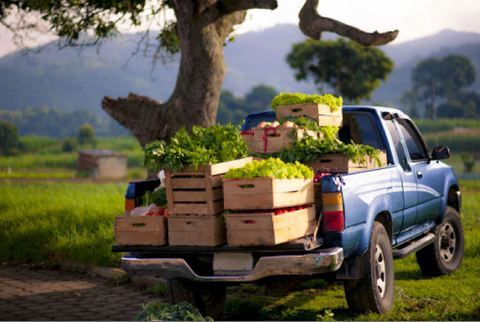Supply chains play a critical role in getting the food from the farmers to your dinner plates. After all, in most cases, we’re not buying direct from the farmer, or growing the produce ourselves, so some “middle people” are inevitable.
However, Inefficient supply chains can add to the cost of food – and in a cost-of-living crisis, no one wants that. But they can also affect the quality of the produce, meaning that you’re often paying more for less.
Untangling the issues that Australia has with its supply chains is more complex than it might sound, which is why Good & Fugly, with our streamlined approach of delivering our boxes of produce direct from the farmer to the consumer, is superior, and key to the reason that the boxes that you’ll get delivered from us are as fresh and delicious as they are fugly.
But first, an overview of how supply chains work.
The Traditional Supermarket Supply Chain
The traditional supply chain, for the food that you’ll find in Woolworths, Coles, ALDI and other supermarkets, works like this:
1. Farm to Distributor
Australian farmers cultivate a diverse range of crops, from juicy tomatoes to crisp lettuce. They invest time, effort, and resources into growing high-quality produce, and then come harvesting time, ship that produce off to distributors.
The distributor’s business is to buy massive, bulk quantities of these fruits and vegetables from farmers. They then aggregate products from various sources and transport them to distribution centres. Essentially, the distributor acts to “collect” the produce from a large number of farmers, right across the country.
2. Distribution Centres
The first role of a distribution centre is to sort, grade, and package the produce. It is at this point that the quality control measures are implemented to ensure only the best items proceed. Conversely, this is where farmers find that a lot of their produce is rejected, meaning that they will need to find another use for it, or they will need to throw it into waste.
The produce that is kept is then stored in temperature-controlled warehouses before being shipped to regional distribution centres.
3. Regional Distribution Centres
Yes, it’s another distribution centre! Regional distribution centres play a different role, however. These centres serve as hubs for supplying supermarkets within specific areas. So, for example, each city will have distribution centres, and in country Australia, a cluster of towns within a region will likely be served by a single distribution centre.
It is from here that trucks will be packed up with the produce and sent to the supermarkets to stock the shelves.
This process of going through the various distribution centres, and the number of hands that handle the produce, mean that it’s rarely at its freshest when it arrives on the shelves. It might look great – because the supermarkets heavily screen for that – but you might not enjoy the flavours so much.
Contrast that to the Good & Fugly approach:
1. Direct from Farmer to Customer
Yep. It’s as simple as that. Good & Fugly eliminates unnecessary steps by connecting farmers directly with consumers.
Not only is this better for you, because it means that you can be sure that the produce is super-fresh (often delivered on the same day that it’s harvested), but as an added benefit, you can order with the knowledge that you’re supporting the local growers.
Why is the Good & Fugly Approach Good for Farmers?
By bypassing distributors and wholesalers, we can instead ensure that farmers receive fair compensation for their hard work. It’s for the same reason that some farmers set up their own food trucks on the side of highways, or sell at farmer’s markets on weekends. The fewer people that need to be paid in the process of getting the food from the farmer to the consumer, the more revenue the farmer can make while still providing cheaper produce to customers.
Customers also benefit, since the food arrives at peak freshness. Not only does that mean it can be stored for longer, ensuring that you throw out less food because it’s gone past its use-by date. It also has a direct impact on the flavour. Are there vegetables that you or your kids have typically not eaten?
Try again after you order a Good & Fugly box. Chances are, you’ll have a whole new take on that vegetable afterwards!



